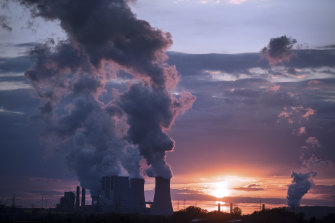By Peter Hannam
October 11, 2020 —
Those are the findings of analysis – commissioned by the Investor Group on Climate Change, a lobby representing institutional investors managing $2 trillion in funds – to assess opportunities if the economy adopted a net zero carbon emissions target for 2050. The Morrison government has rejected such a goal.

Billions of dollars of business opportunities would be opened up if the Australian government aligned the economy with the agreed Paris climate goals, the Investor Group on Climate Change says. CREDIT:JASON SOUTH
Under an orderly transition where policies are clear and consistent, openings in the next five years alone would total $15 billion in manufacturing and $6 billion in transport investment. So-called green hydrogen that taps renewable energy to split hydrogen from water would also lure $3 billion as that industry begins.
By 2050, renewables and other clean power generation would create the largest investment opportunity at $385 billion from 2020 onwards, with green hydrogen next largest at $350 billion in current dollars.
Other significant investment opportunities by mid-century include transport infrastructure at $104 billion, carbon sequestration worth $102 billion, and electricity transmission and distribution at $98 billion, the analysis by consultants Energetics estimates.
Sourcing those funds would generate a boom for finance too, with equity raisings of $525 billion and private debt finance at $322 billion. Corporate and government bond sales would reach $216 billion more.
Emma Herd, IGCC's chief executive, said the analysis was if anything conservative because it excluded the export opportunities if Australia mastered green hydrogen and green steel, which avoids fossil fuels.
“If we get this right, Australia could reap the benefits of $63 billion in fresh private investment over the next five years, and over $1 trillion by mid-century, in domestic opportunities alone," Ms Herd said.
“Many of these prospects are in regional Australia with multibillion-dollar opportunities in carbon farming, renewable energy, transport infrastructure and advanced manufacturing," she said, adding that given the likely post-COVID-19 constraints governments would need markets to do the bulk of the work.
In Australia's case, an orderly transition to a net 2050 goal implies increasing our target to cutting 2005-level emissions 45 per cent by 2030, compared with the actual pledge of 26-28 per cent.
RELATED ARTICLE

FEDERAL BUDGET
'Thrilled': Next generation climate modelling gets budget kickstart
The alternative "hothouse scenario" is for emissions to drop in line with existing international promises, a path "leading severe climate change impacts on economies", which the report doesn't quantify.
Still, a business-as-usual approach will see lost investment opportunities reach $43 billion by 2025 alone, relative to the net-zero alternative. By 2050, these rise to about $265 billion, with renewables topping the list at $65 billion, ahead of $63 billion for green hydrogen production.
The absence of a clear market signal has been one of a number of risks facing investors everywhere, the report said.
"These investment risks are more acute in Australia due to a history of ad hoc policy interventions, a piecemeal approach to energy and the lack of a bipartisan, long-term approach to climate policy," it said.
The report also raised doubts about the long-term viability of gas, a key part of the Morrison government's post-coronavirus recovery plan.
"[G]lobal capital markets will increasingly scrutinise the climate risks associated with gas, leading to preferential investment in true zero-emissions alternatives."
"This is borne out in the Energetics modelling, which shows no large-scale investment in gas power generation or infrastructure under either [net zero or hothouse] scenario as renewable energy and storage are cheaper alternatives," it said.













